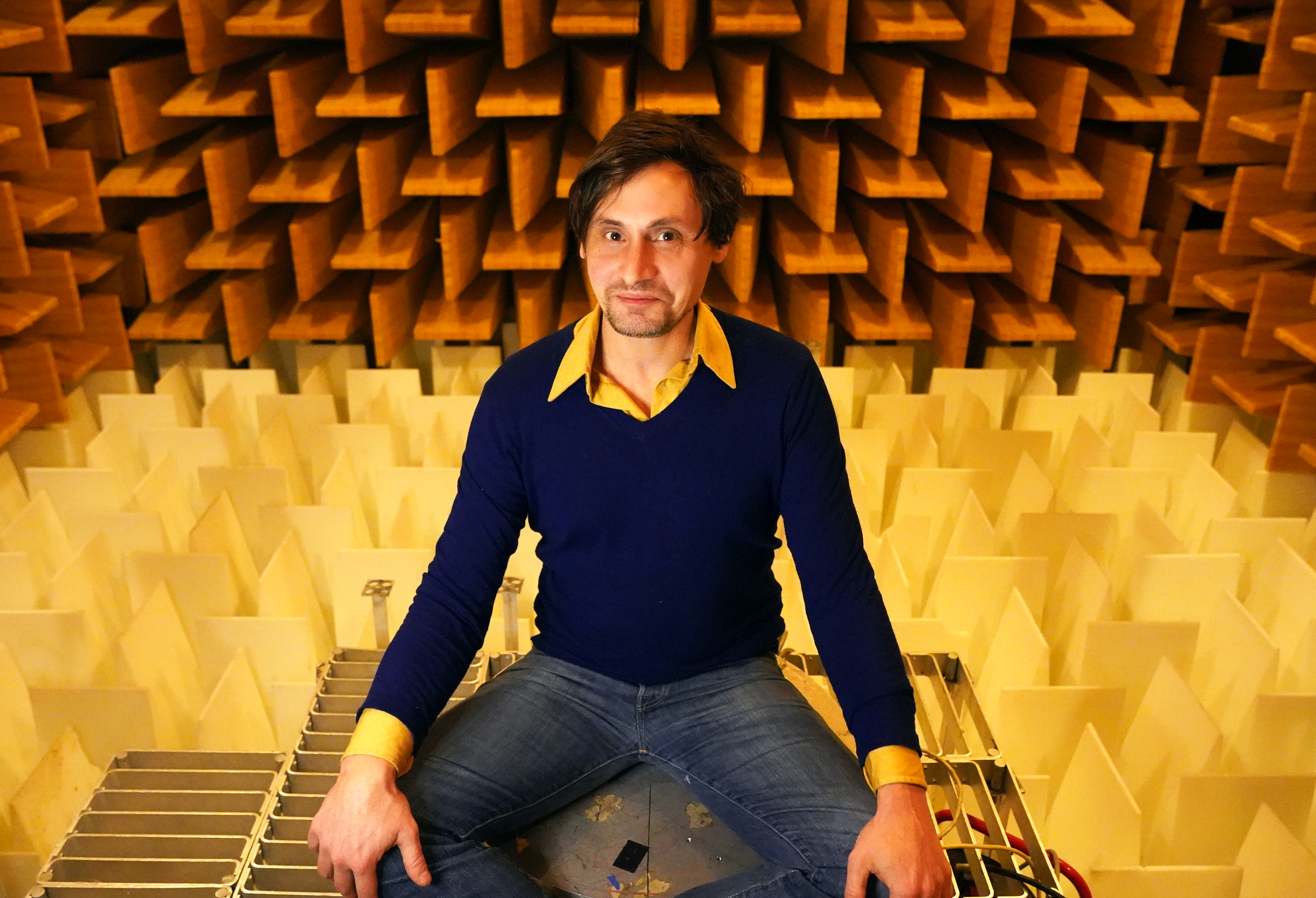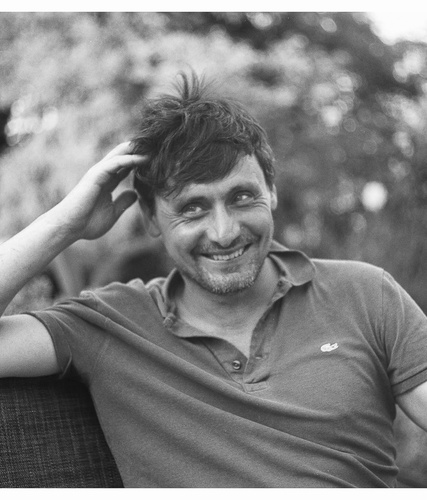Sébastien Gaxie en studio
De la bande dessinée à la bande son - Enheux artistiques
Lorsque le Centre Pompidou, en partenariat avec l’Ircam, songe à passer commande d’un environnement musical pour une salle de l’exposition «Bande Dessinée (1964- 2024)», le nom de Sébastien Gaxie s’est rapidement imposé. Sa personnalité atypique, l’éclectisme de ses inspirations (littérature, danse, cinéma, animation, et même gastronomie), la variété de ses champs d’expression (contemporaine, jazz, électronique, théâtre musical, littérature, art vidéo...) et ses recherches sonores en marge de la scène actuelle en font en effet un candidat idéal. Surtout, un de ses récents projets, Auctus Animalis, distingué du prix Swiss Life, comprend justement une exposition sonorisée.
 Sébastien Gaxie photographié dans la chambre anéchoique de l'Ircam
Sébastien Gaxie photographié dans la chambre anéchoique de l'Ircam
Sébastien Gaxie est immédiatement séduit par la proposition, et plus encore par la nature des quatre BD choisies : toutes des adaptations d’œuvres littéraires. «Interroger le passage du littéraire à la BD m’a tout de suite intéressé. D’autant que ce sont quatre textes très différents, appartenant chacun à une époque bien particulière. Le plus ancien est le Pinocchio de Carlo Collodi, librement adapté et remis à sa main par Winshluss en 2008. Vient ensuite Des souris et des hommes de John Steinbeck par Rébecca Dautremer (2009), puis Brouillard au pont Tolbiac, de Léo Malet, premier Nestor Burma que Tardi a adapté en 1996. Et, enfin, Vernon Subutex de Virginie Despentes dont Luz s’est emparé en 2020, avec Despentes elle-même au scénario. »
La composition s’est appuyée sur trois principes directeurs :
- Premier principe: une écriture «cinématographique », comprenant des voix (textes et impressions non verbales) et un montage son de type cinéma (fonds d’air, bruitages...).
- Deuxième principe : le surlignage vocal des protagonistes, qui consiste à dégager une mélodie d’une voix disant un texte. Quand on parle, la voix reste rarement sur une seule et même note. Au contraire : chaque phonème est dit sur une note particulière, et la courbe mélodique dépend de la teneur expressive de la phrase (joie, tristesse, angoisse, etc.). Si la technique n’est pas une invention de Sébastien Gaxie, elle a intégré sa boite à outils en tant que génératrice de matériau et d’expressivité. Dans le cas qui nous occupe, il a fait lire à des comédiennes et comédiens les textes des bulles – en utilisant parfois la langue de la version originale pour varier les sonorités – les dirigeant à la manière d’un metteur en scène de théâtre (cris et chuchotements compris). Relevant ces « mélodies », il les a orchestrées à l’aide de synthèse instrumentale ou avec de véritables instruments, ladite orchestration devant naturellement refléter le caractère de chaque personnage – ainsi du marimba pour Pinocchio...
- Troisième et dernier principe : organiser une dramaturgie. À cet égard, Gaxie s’est astreint, pour chaque planche, à suivre strictement l’enchaînement des cases, la trajectoire sonore accompagnant celle de l’œil du lecteur. Au spectateur d’imaginer son propre film.
« Je jongle entre différents types de morcellement de l’espace, entre des passages polyphoniques, où toutes les BD se mêlent, et des focus sur les planches successives. Le rapport à l’espace doit être inlassablement renouvelé. »
« S’inscrivant dans des époques historiques distinctes, les quatre BD permettent d’explorer différents styles musicaux. Ainsi, la partition de Des souris et des hommes rappellera Prokofiev, dans cette écriture de l’instant, très théâtrale, qui m’a fascinée à la relecture de Steinbeck prolongé par Dautremer. Quant à Vernon Subutex, j’ai pris le parti d’une synthèse très années 80, très électro, accompagnée de bruits de vinyles qui reflètent l’atmosphère de l’extrait choisi. Dans son livre, Despentes enchaîne les références musicales, manière pour elle de décrire la trajectoire émotionnelle de son personnage. J’ai voulu lui faire le cadeau de mettre en musique ce qu’elle avait imaginé – en collant à ses références. »
L’EXPOSITION MUSÉALE : UNE CONTRAINTE EN SOI
Enjeux technologiques
«J’ai rarement eu des bonnes expériences de son muséal, dit Sébastien Gaxie. Je le trouve souvent soit non pertinent, soit trop envahissant. Dans le cadre de cette exposition, je veux qu’on associe immédiatement le son à l’image. Outre l’environnement informatique et le dispositif de diffusion sonore (avec notamment un haut- parleur au-dessus de chaque photo) que nous avions développé avec Manuel Poletti, l’expérience d’Auctus Animalis m’a appris qu’il faut un renouvellement assez fréquent du mode sonore diffusé, mais aussi que les trajectoires des visiteurs au travers de l’espace muséal peuvent être suggérées par la localisation du son. Cela doit constituer un principe fort dans la réflexion pour l’organisation sonore de l’espace. »
La nature même d’un espace d’exposition vient avec son lot de contraintes. À commencer par la gestion des flux: il serait inenvisageable d’engorger le passage en laissant se masser les visiteurs devant une planche !
Autre idée reprise d'Auctus Animalis : le principe d’un son référent qui permet de reconnaître en quelques secondes l’identité sonore d’une BD. Ces sons – qui renvoient aux fonds d’air et bruitages cinématographiques – sont déduits des planches exposées: la scène choisie pour Des souris et des hommes se déroulant dans une étable, les bruits d’un cheval se sont imposés. Pour Brouillard au pont Tolbiac, c’est une atmosphère de métro, tandis que Vernon Subutex est plongé dans la rumeur de la nuit citadine.
« Ces sons référents me permettent de morceler l’espace, d’inviter à la déambulation, mais aussi à créer des focalisations de l’attention, pour pénétrer tour à tour les univers spécifiques à chacune des quatre BD. Le reste du temps, le discours doit circuler plus rapidement afin de laisser coexister le micro et le macro. Mais, en définitive, tout cela reste un jeu d’enfant. »
Par Jérémie Szpirglas
Biographie
Sébastien Gaxie
Compositeur, pianiste et écrivain né en 1977, il grandit entre l’étude du piano et la vie de petit chanteur. Adolescent, il découvre le jazz avant d’intégrer plus tard le Conservatoire de Paris en composition, où il devient élève d’Emmanuel Nunes. Il tra…



